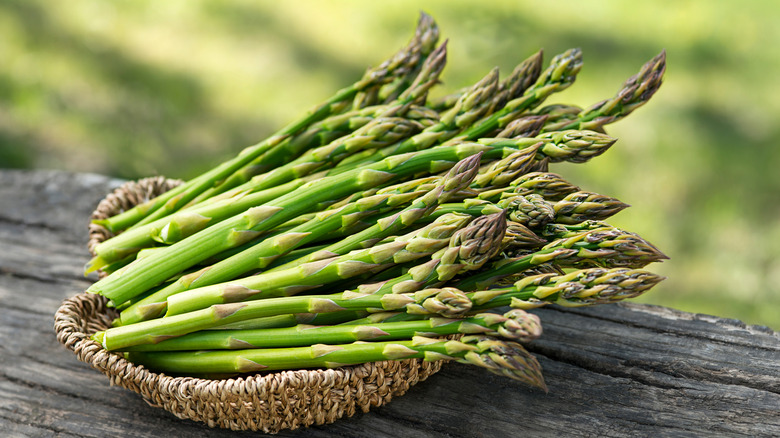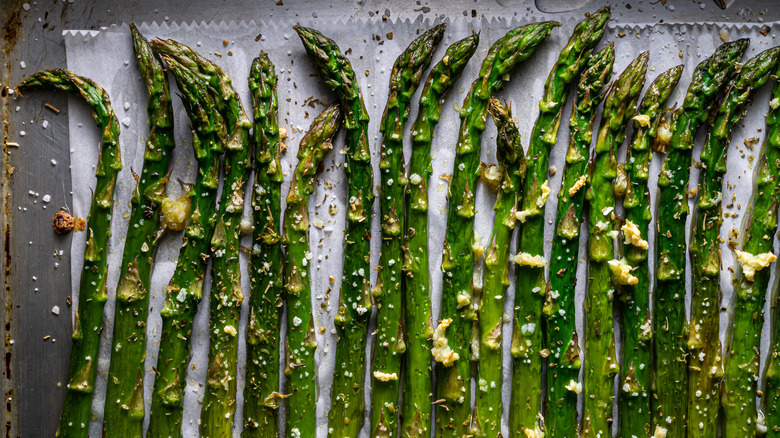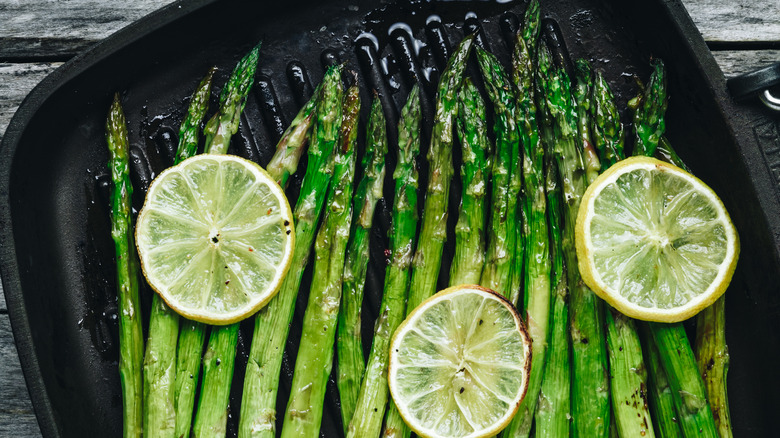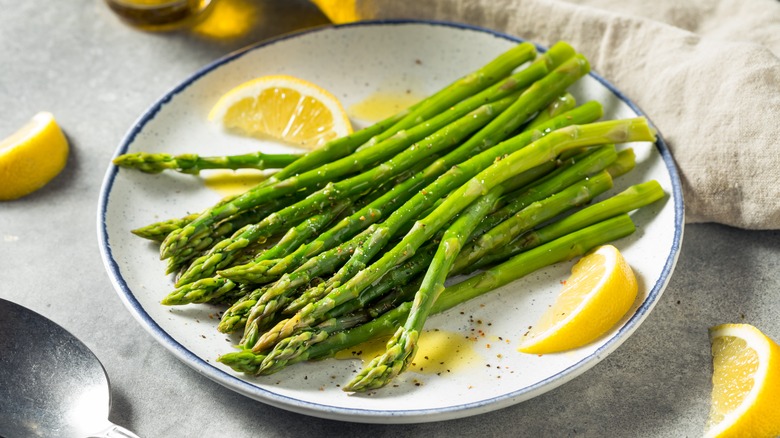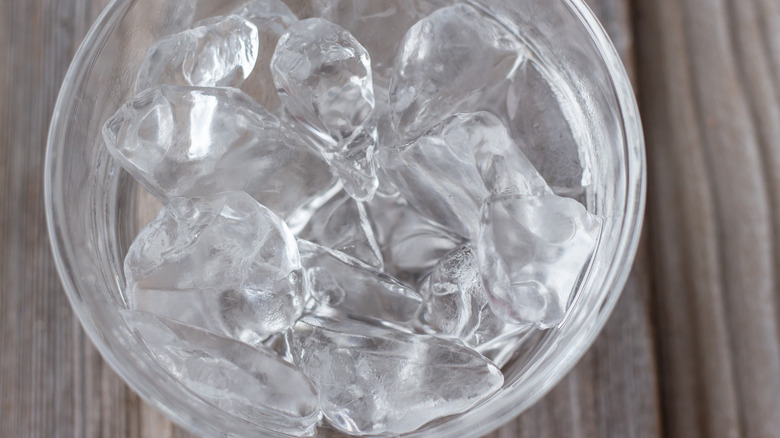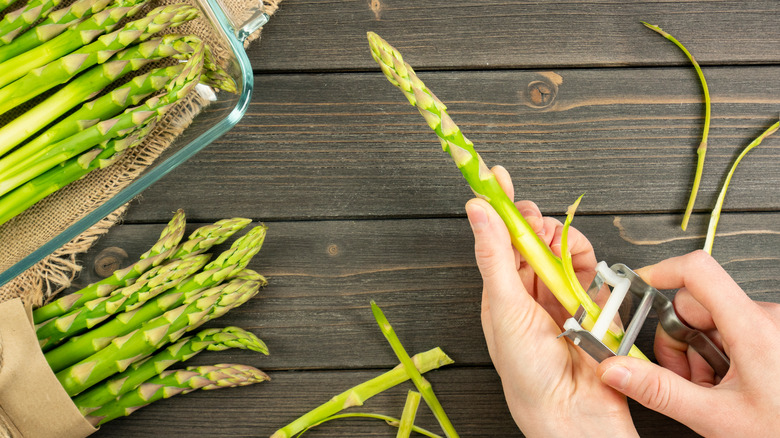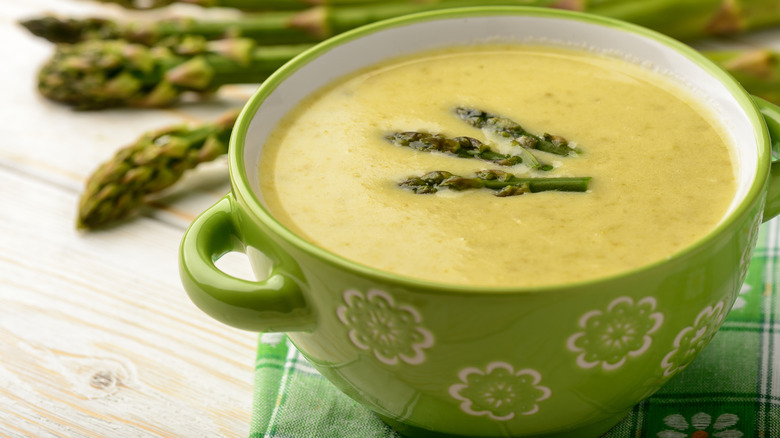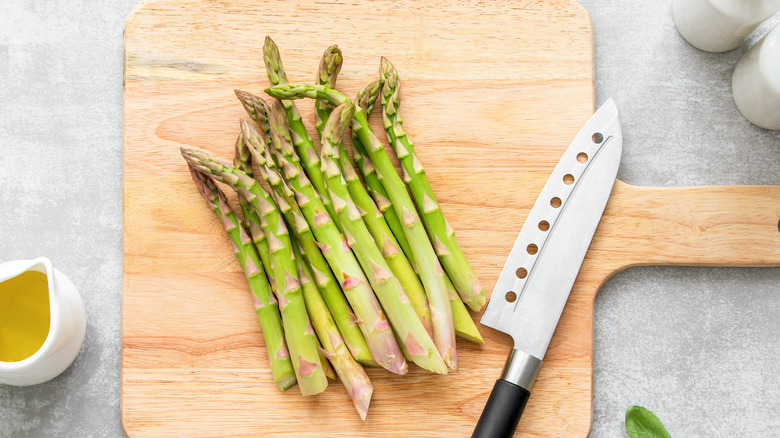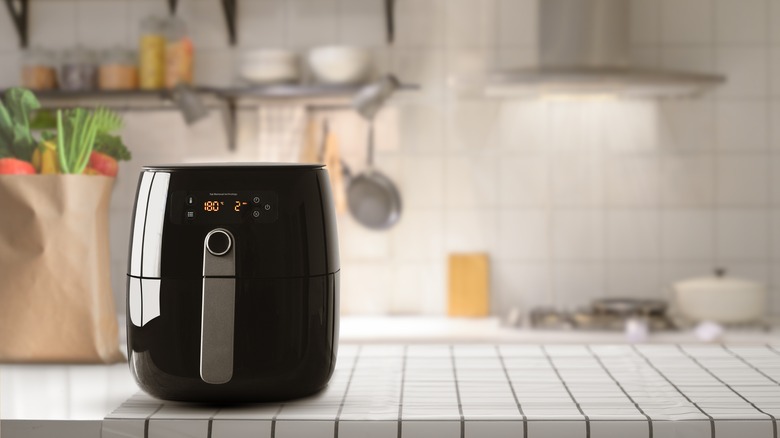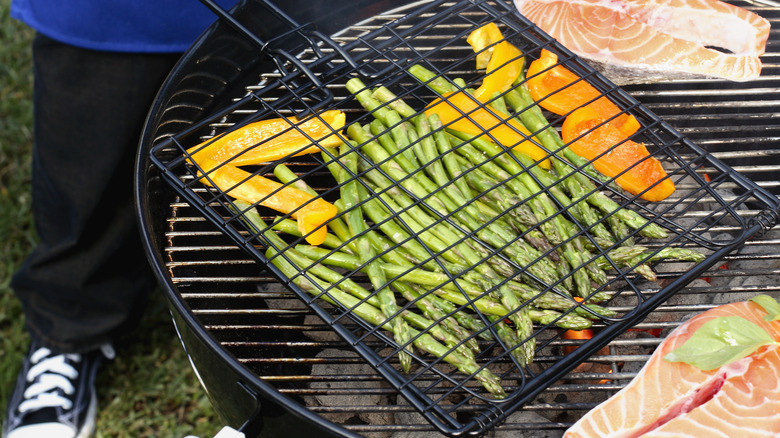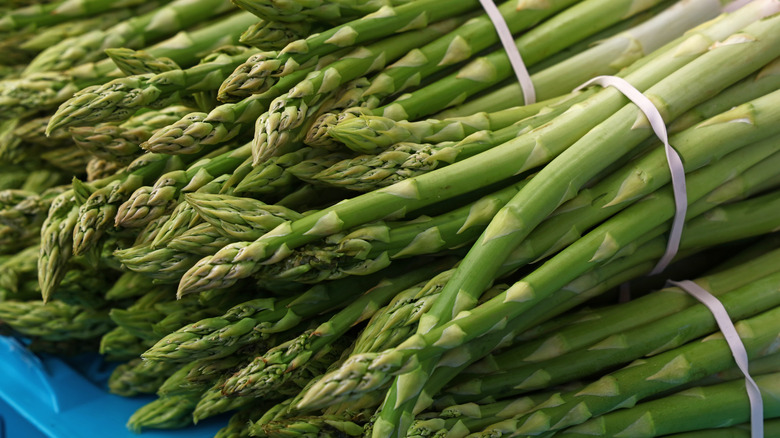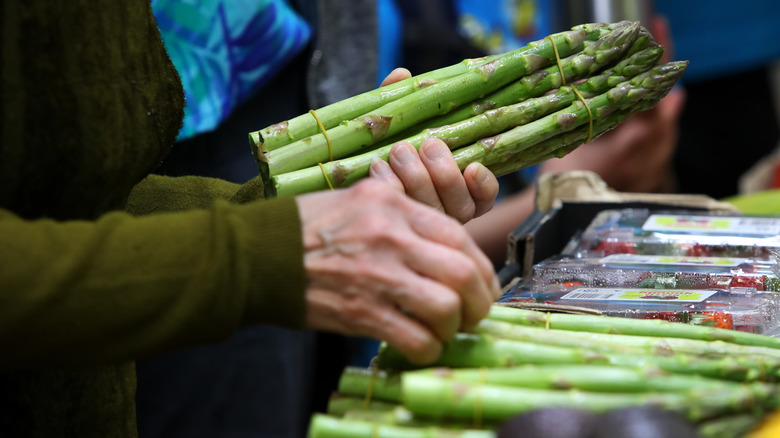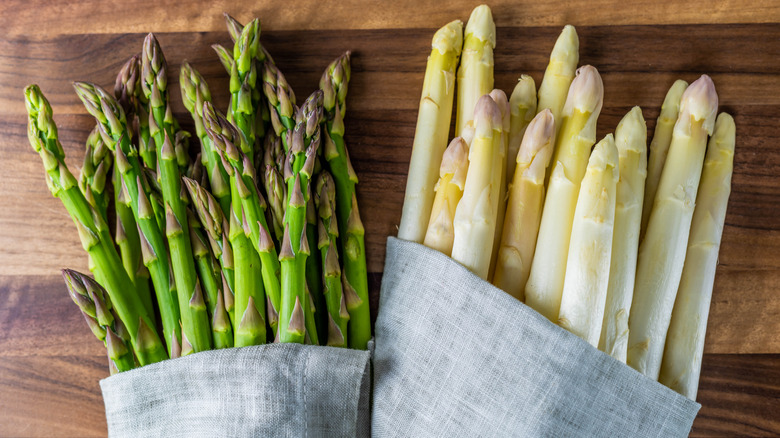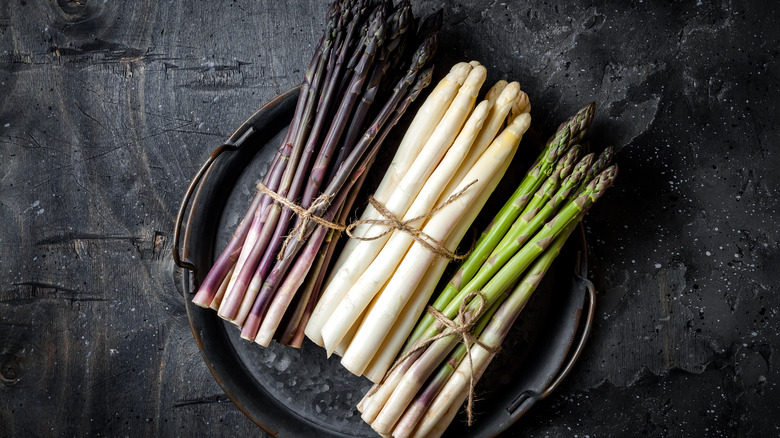13 Tips You Need When Cooking With Asparagus
As a kid, you might have had an adverse reaction to asparagus. And yet, this plant has a way of growing on you. The older you become, the more in line with your taste buds it becomes. It's as if you needed to evolve your own enjoyment of food to fully embrace the exceptional flavor locked inside an asparagus stalk. Of course, knowing how to properly cook asparagus can absolutely make or break your asparagus-eating experience. We're not going to say whoever was cooking the veggie for you as a kid didn't know what they were doing, but we are saying there are far better ways to serve it than the limp, dull, over-boiled offering far too much of us were stuck picking at while growing up.
Asparagus has the potential to be a delicious and nutritious addition to any meal. With several colorful variations of asparagus at your fingertips and a number of cooking methods, with just a few tips you will wield the power to convince even the smallest of your children of just how good asparagus can be (without dousing it with cheese). However, if you are not careful, asparagus can also be limp, flavorless, hot on the outside, and ice cold on the inside. With all those flaws, even wrapping the vegetable in bacon won't save it. That is exactly why you need to know how the ins and outs of cooking with asparagus.
Consider oven roasting
Do you struggle to keep your asparagus crispy? Maybe it tastes bland and lifeless when you sauté or steam it. For a foolproof way of cooking deliciously crispy and flavorful asparagus, look to the oven. Sure, it takes longer, but it's easier to monitor, and you can even get some char on, if that's something you enjoy.
Using a regular baking sheet will work perfectly well for this task, but if you have a cast iron baking skillet with ridges, you'll be able to add some of those fantastic grill marks. Don't want to wait for the oven to heat up, or maybe you have something else cooking? If you have a toaster oven this will also work as well. In fact, we love cooking with toaster ovens because they very much work just like a conventional oven, only with the less heat-up time involved (not to mention the tiny appliance uses far less energy, which is good for saving you money as well as keeping your kitchen from increasing in temperature).
Bring added flavors into the oven
Another benefit when it comes to roasting your asparagus is you can easily add secondary flavors to the vegetable to help your taste buds come to life. This can be roasting the asparagus with garlic, squirting the plant with lemon, or using a little olive oil drizzle as the fat can be absorbed by the asparagus.
These are some of the most common ingredients used when roasting asparagus, but there's no reason why you can't completely make it your own. You can roast the asparagus with its own veggie medley, in which case the entire oven will become infused with all the veggies. It can be something as easy as carrots and potatoes, although we also enjoy tossing in some parsnips, thanks to the sweeter taste the vegetables bring.
Don't want to deal with roasting other veggies? Not a problem, as you can go with something as easy as butter. Instead of drizzling with olive oil, brush the plants with butter with more of a savory taste. You can even go spicy and roast the asparagus with some chipotle peppers, which brings a nice, smokey spice taste.
Steam for maximum nutrients
If you're eating asparagus specifically for the nutrient content, you will want to steam the veggie. This is the best way to maintain the nutritional integrity not only of the asparagus but of any veggie you cook. The steam will cook the vegetables without pulling some of the nutritional elements out.
Boiling the asparagus, for example, will pull nutrients out of the plant and into the water. Grilling the veggies, as well as baking them, will also kill off some of the nutrients, as well. This is where you need to make your decision as to which cooking form you want to take advantage of. If you want maximum flavor, look to baking or grilling. If you want maximum nutritional value, opt for steaming. You can always add some seasoning or butter later, once the veggies have cooked through. Just make sure, when you're steaming the veggies, to remove them from heat once cooked through, otherwise you risk making them damp and soggy.
Blanch your asparagus
Maybe you purchased too much asparagus at the farmers market and you're now worried it is going to go bad before you have a chance of eating it, or you simply need to buy your stalks a few more days before a meal or holiday gathering. In these cases, your best bet is to blanch them. Blanching is a process of dunking the vegetables into a pot of boiling water briefly, then removing the veggies and dunking them into ice water. This will help prevent the loss of flavor or color.
Chances are, if you have watched any cooking shows in the past, you've seen the host blanch something at some point during the run of the program. They do it on the show, and yet they might not fully explain what blanching does. It's always good to know what something does in the kitchen. Going from hot to cold shocks the system of the plant. This effectively stops internal enzymes from deteriorating, which will help prevent any loss of flavor, texture, or even color. However, make sure you correctly blanch your asparagus. Under-blanching is actually worse for the vegetables than not blanching at all.
For extra tender asparagus, peel it
Do you find your asparagus a bit tough, even after you bake it to what should be perfection? It can be pretty frustrating. You know that if you keep the asparagus in the oven longer you might be able to rid it of that woody texture, and yet you'd likely scorch all the flavor out of it. It can feel like you're stuck between a rock and a hard place.
Is this something you just have to accept? That those thicker pieces of asparagus are just going to end up woody and there's nothing you can do about it? Thankfully not, and one particular culinary legend had an excellent suggestion for avoiding this very problem. Julia Child recommended for tender roasted asparagus, in order to avoid that tough texture, you should peel the asparagus prior to baking, as this will help the plant cook through and give you a nice, tender bite every time.
Soup rescues your leftover asparagus
Do you have a plate of leftover asparagus and you're not really sure what to do with it? Baking the asparagus or using it as its own side again doesn't usually work. It will end up limp and lacking any kind of fantastic texture. That is why you should instead use it in soup. You want the asparagus to be tender in the soup anyway. If your mother would toss leftovers into a giant pot and make an asparagus soup concoction, she knew what she was doing. While we wouldn't recommend just tossing anything into the soup, it's a good saver for your asparagus.
Maybe you were able to polish off all the asparagus you cooked. That's always a nice feel. At least until you look into the trash and see all those little bits you chopped off during preparation. While we don't recommend fishing through the garbage to pull those out, your next time through you can use the asparagus ends in soup. That's much better than letting the pieces go to waste.
Cut the ends, don't snap
There's an age-old "technique" of snapping the woody part of asparagus off by bending the two ends together. The idea behind this is the asparagus will naturally snap where the tender portion of the asparagus meets the thicker, woodier part. This, however, doesn't always work. Have you ever tried to snap a small twig off of a tree or bush in the yard, only to have a larger portion break off instead? This is absolutely not the outcome you were going for, and yet it is very similar to what can happen with your asparagus.
Instead, just use the knife. It's faster, and you won't lose as much asparagus in the process. And remember, once you cut that woody part off the asparagus stalks don't toss them away. Save them for some asparagus soup. Here is a delicious and easy-to-make cream of asparagus soup you can whip up with those spare bits you chopped off.
Why not air-fry it?
With so many other things going on in the kitchen, wouldn't it be great if there was another way to cook it? The oven is already packed full of other dishes for a big holiday meal, and yet the asparagus is sitting there on the counter, watching you, wondering when it will be its turn for cooking. If you want a foolproof way to cook up your asparagus that isn't going to take up much additional space inside the kitchen, you need to take advantage of your air fryer.
Yup, the air fryer is good for pretty much everything. Whether you're looking to cook asparagus for a holiday meal, or you have leftovers and you don't know what to do with them to breathe new life into the now limp vegetables, the air fryer might just be your best friend. Now, it is important to keep in mind that while air frying is significantly healthier than traditional frying, you are still adding calories from the oil used in the fryer. If this isn't a concern, take advantage of that air fryer. But if it is, you'll want to stick with one of the other cooking methods.
Grill asparagus as you would meat
Grilling asparagus is a fantastic way to add some char and infuse it with smoke. You're cooking the asparagus overheat, so it is, in many ways, similar to baking the asparagus. We love cooking asparagus over wood or charcoal as it can then take on some of the flavor infusion from those cooking methods, but there's absolutely nothing wrong with using a gas grill.
There is something you need to keep in mind though when it comes to grilling your asparagus. One of the biggest sins asparagus grillers perpetuate while trying to cook the vegetable is they push it to the back of the grill, setting it aside, and forgetting about it. The asparagus doesn't receive any additional attention until each piece is mercifully pulled off the grill. Don't do that. Instead, treat it like you would a piece of meat. Add seasoning, and don't be afraid to place it over a smoky portion of the grill. You can even spritz it with citrus for an added fresh taste. You don't need to regulate the asparagus to that second-tier level on the grill that folds out when opening the top. Yes, asparagus can cook quickly because it is on the thinner side, but it handles heat well and is perfectly fine with being over flames or the hot part of the grill. So up your asparagus grilling game this summer and give it the same kind of love and attention as meat.
Remove the rubber band quickly
Typically, when you purchase asparagus it will come bundled tightly with a rubber band. This works for securing a bundle and keeping it together, but over time the rubber band will bruise the vegetable. Instead, the first thing you should do with a fresh bunch of asparagus is cut that sucker off. Give your veggies some elbow room.
Once you have clipped the rubber band off you should take a few additional steps to help keep your asparagus fresher for longer. In many ways, you can care for your asparagus as you would a bouquet of flowers (feel free to give your partner a side eye as you try to remember the last time they gave you flowers). With the asparagus, if you're going to eat them the same day spread them out on the counter or in a dish. If you're saving them for a few days you can take a damp paper towel and wrap it around the stalk. This will help keep the veggies fresh for a few more days.
Male and female... asparagus?
In the plant world, asparagus is what is referred to as "dioecious." In case you don't have a Webster's on hand (or a high school science book), the definition of this is a plant or animal that has male and female reproductive organs in separate individuals. Basically, unlike most other plants, which have both male and female and can easily pollinate themselves with the help of friendly butterflies and bees, some asparagus are male, and others are female.
When looking at your asparagus, the male plants are thicker, while the female plants are thinner. So, if you have ever wondered why some asparagus are fat and others are tall and skinny, this is the reason why. Maybe just as interesting is asparagus is not the only plant you likely interact with that has two "sexes." Kiwi plants are male and female, as is the ginkgo plant. Even the cannabis plant is considered dioecious.
White asparagus is basically green asparagus
There you are, in the store, and you're looking at the green and white asparagus. You've always gone with green, but white is curious to you. Maybe you wonder what it tastes like, and if it's worth the money to try the white asparagus out over the green you normally go for. Well, we are here to tell you that you don't need to wonder what white asparagus tastes like. Why? Because it is essentially green asparagus, just minus the sunlight.
The development of white asparagus happens because farmers place additional soil over the plant, and then harvest it before it emerges from the soil. Due to this, it never has the chance for the sun to interact with the plant and develop its color. So don't get fooled into paying more for white asparagus. Green asparagus is nothing but white asparagus with a sun tan.
Grab purple asparagus when you want it tender
Purple asparagus has less fiber than green (and white) asparagus. This allows the plant to cook into a far more tender finished product. Additionally, it has a higher antioxidant level than other kinds of asparagus, so it might be worth paying the extra charge to go with purple.
It is important to keep one thing in mind though. When shopping around for asparagus you might find purple asparagus and Purple Passion asparagus. The two are not one and the same. Purple asparagus has a purple tint to it, but you can still see the green underneath (it's as if someone did a quick purple pass over green asparagus but didn't come around for a second coat). Purple Passion is a very deep purple. There is no green peaking through. This particular kind of asparagus is far sweeter than the other kinds of asparagus you're going to find at the grocery store, thanks to the higher levels of natural sugar. It is also far more expensive asparagus and one you're probably going to find at more high-end farmer's markets and produce stores than at your general grocery store. However, if you're struggling with convincing your children to eat their asparagus, it might be worth testing these out.
